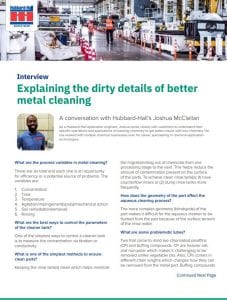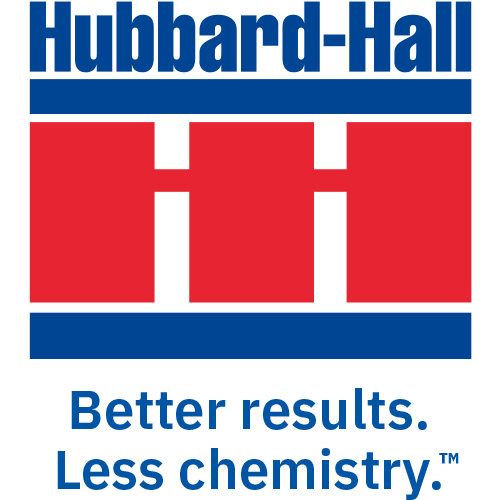A conversation with Hubbard-Hall’s Joshua McClellan
As a Hubbard-Hall application engineer, Joshua works closely with customers to understand their specific operations and applications of cleaning chemistry to get better results with less chemistry. He has worked with multiple chemical businesses over his career, specializing in chemical application technologies.

What are the process variables in metal cleaning?
There are six total and each one is an opportunity for efficiency or a potential source of problems. The variables are:
1. Concentration
2. Time
3. Temperature
4. Agitation/impingement(spray)/mechanical action
5. Soil remediation(removal)
6. Rinsing
What are the best ways to control the parameters of the cleaner tank?
One of the simplest ways to control a cleaner tank is to measure the concentration via titration or conductivity.
What is one of the simplest methods to ensure clean parts?
Keeping the rinse tank(s) clean which helps minimize the migration/drag out of chemicals from one processing stage to the next. This helps reduce the amount of contamination present on the surface of the parts. To achieve clean rinse tank(s); (1) have counterflow rinses or (2) dump rinse tanks more frequently.
How does the geometry of the part affect the aqueous cleaning process?
The more complex geometry (blindspots) of the part makes it difficult for the aqueous cleaner to be flushed from the part because of the surface tension of the rinse water.
What are some problematic lubes?
Two that come to mind are chlorinated paraffins (CP) and buffing compounds. CP are heavier oils and non-polar which makes it challenging to be removed unlike vegetable oils. Also, CPs comes in
different chain lengths which changes how they can be removed from the metal part. Buffing compounds are usually lard oils and fats. During the buffing process there is a lot of friction and heat created which allows the buffing compounds to penetrate through the pores of the metal. As a result, it can be challenging to remove from softer metals like aluminum and brass.
How to extend cleaner tanks?
You can extend the bath life by using mechanical technology to help reclaim the cleaning solutions. Depending on the chemistry of the cleaning solution you can emulsify the oils or split the oils out of the
solution. From there you can use an oil separator, oil coalescer, or oil skimmer. A newer technology being used is membrane filtration which works best with emulsifier cleaners.
How can I clean aluminum without etching the surface?
There are many ways that you can clean aluminum without etching the surface. One of the best ways isto use a formulated mild to neutral pH cleaner that will not etch the surface of the part.
How do you clean zinc properly?
Zinc is a very sensitive metal and is highly reactive with strong acids and alkaline cleaners. The best way to clean zinc is using milder, inhibited pH cleaners that will not attack the surface of the part.
What methods are used to determine if the parts are cleaned after going through the cleaning process?
There are several types of methods that you can use to help determine if the parts are cleaned. I recommend the water-break test and white glove test. For the water break test, you are looking to see how the water breaks (during rinsing) from the part after been cleaned. If you see water droplets on the parts, that indicates there is still oil on the parts. The Water-break test does not work with soap-based cleaners because of the surfactant package. For the white glove test, you wipe the part using a white glove. If the white glove is no longer white, the part is still dirty.







Leave a Reply